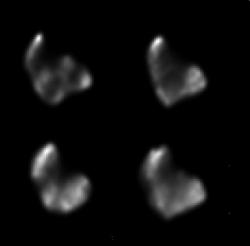NY40 2002 approached the Earth one and a half times beyond the lunar orbit and was the closest object of its kind since 1931* Now the analysis of the observations conducted on it during the approach and the scientific insights from them is being published

2002 NY40 was first discovered as part of the Linar Automated Search Project, operating from observatories in New Mexico, on July 14, 2002. A month later it made its closest approach to Earth. As it got closer, its brightness increased and reached magnitude 8 - although a brightness that is not visible to the naked eye, but can be easily viewed with amateur binoculars and telescopes, if they knew where to look.
This is a rare event, near-Earth asteroids reach such a distance once every 50 years or so. The previous asteroid to approach this distance was EA 2001 CU11 which passed slightly behind the Moon's orbit on August 31, 1925. It too was not discovered until 77 years later after it had passed again and only after this pass, astronomers were able to calculate when it last passed us.
On the evening of August 17, asteroid NY40 made its closest approach to Earth. During that night, astronomers all over the world, including a team of researchers from Boeing and the US Air Force focused on it. The Boeing and Air Force team used the AEOS corrective optics telescope in Hawaii to study the asteroid in as fine detail as possible, and they revealed many features on the asteroid's surface. Using this information they were able to better understand the physical structure of the asteroid, and gain insight into its chemical structure. The results of the study will be published in the next issue of the Ikarus journal.

6 תגובות
The main thing you forgot
The bodies richest in water in the solar system are the comets, so please change the plans to comets.
Besides, if you have a spare Comet, then please. In a sweep, they landed him in the Sea of Galilee.
Happy holiday
Sabdarmish Yehuda
Tilting the icy asteroid is the easy part.
All that is needed is an oven that will heat the ice and produce steam from it
and a propeller to expel the steam
thus giving the asteroid momentum in the opposite direction.
A simple control mechanism will be able to perform this task automatically.
The ice could be used as a gas source
in the transition maneuvers to the next asteroid.
The most problematic section is likely to be landing on top of a rapidly moving rotating body
and docking on his face (attachment to him).
On top of that, designing a complex machine that will function
in the extreme conditions prevailing in space
For decades
can be a difficult task.
Magnitude 8 is less bright than at least one asteroid right now.
The most important figure was not provided...
What was the size of this bone? No, 10 meters as mountains
A kilometer or 10 kilometers?
You can, but I'm tired and I really don't have the energy for it
maybe tomorrow
Good night !
It is interesting if asteroids that are mostly made of water can be made to bombard Mars and thus provide it with increasing amounts of water in order to create an environment that will allow animals to grow on it. A kind of small spacecraft that will sit on an asteroid and point it towards Mars and as soon as the asteroid adjusts, the spacecraft will fly and move to another asteroid and adjust it too and God forbid.